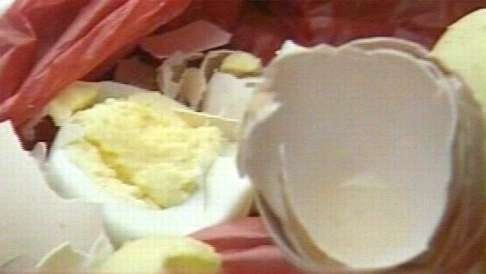Inside Out | Criminal gangs are making huge profits using one of the oldest tricks to deceive shoppers
Fake or adulterated food is pervasive on our consumer shelves, according to experts

For your base mix, take some sodium alginate, add water, and stir for 90 minutes; add gelatin and leave for 10 hours; finally, add sodium benzoate and alum, and some lactones to taste. Now you are ready. Add some yellow colouring agent, and pour mix into small round moulds. Dip in calcium chloride to thicken. When these have firmed, dip into the original uncoloured base mix in an egg-shaped mould. Finally, dip this in a mixture of paraffin wax and gypsum, for a nice shiny hard shell.
And there you have it: an egg. Produced in 24 hours and at a quarter of the cost of letting a chicken poop it out naturally. Oh, and by the way – if you dye your base mix green, you have fake grapes too. Welcome to the world of food fraud.
When I first heard of Chinese fake eggs in 2011, I really could not believe it. The sheer ingenuity of it. The astonishing reality that a chemist can make an egg more cheaply than a hen.
New Zealand’s exporters of the rare and expensive manuka honey ...recently had to confront awkward questions from their loyal customers worldwide
Of course, most food fraud and adulteration is much less ingenious. It may just be a matter of adding water to bulk up the weight of some ham, or pouring cheap canola into extra virgin olive oil, or taking farmed salmon and calling it wild catch. And of course such frauds are not new: in ancient Rome, wine sellers added lead to sour wine to hide the fact that it had gone off – perhaps a reason why so many of Rome’s wealthy classes were sterile and mentally retarded.

According to Richard Evershed, professor of biochemistry at Bristol university in the UK, as you next wander down the aisle of a Parkn’shop or Wellcome supermarket, you need to bear in mind that in supermarkets worldwide, at least 10% of the products on the shelves have been adulterated. It is not that Parkn’shop and Wellcome are deliberately aiming to defraud or deceive us. It is that food adulteration is pervasive, and that food sellers are in a constant cat-and-mouse battle with food fraudsters to keep our food safe and honest: “We have created an ideal environment for criminals to operate within our global food system,” Evershed says with his collaborator Nicola Temple in their newly published book, Sorting the Beef from the Bull: the Science of Food Fraud Forensics.
In the US, the marine environmental group Oceana recently sampled 1,200 seafood products on sale in 674 retail outletsand found that 33% were mislabelled. That premium priced red snapper was actually farmed tilapia: much cheaper, and who is going to notice?
New Zealand’s exporters of the rare and expensive manuka honey – produced by bees that feed on New Zealand’s health-giving manuka tree – recently had to confront awkward questions from their loyal customers worldwide: if they manage to produce just 1,900 tonnes of manuka honey a year, how come world sales last year amounted to 9,070 tonnes?
